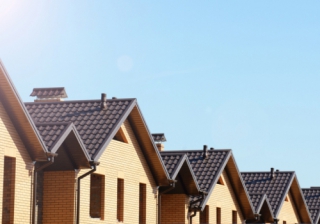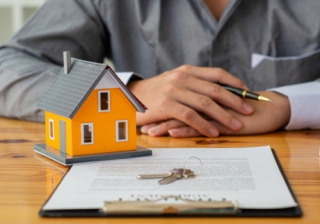
"Prices are now settling rather than sliding, and the market remains firmly in a period of transition. The trouble is no-one yet knows what it’s transitioning to."
House price growth picked up to 1.1% in February, from 0.2% in January and -1.3% in December, the latest Halifax house price index shows.
The annual rate of house price growth remained at 2.1% for the third consecutive month, with the average UK property now costing £285,476.
However, the rate of annual growth slowed in all nations and regions during February.
Annual growth reduced most significantly in the North East, at 1.1% in February vs a rise of 3.6% in January.
Average house prices in London are now £526,842, down by -0.9% over the last year. London may be affected by its large proportion of flats – prices for which have broadly stagnated. Despite this slowdown, homes in London still cost over £240,000 more than the UK national average.
Annual growth fell the least in Scotland. House prices in the nation are now an average £198,779 - a growth rate of 2.2%, vs 2.3% in January.
Similarly in Wales, annual growth in February was 1.2% vs 1.9% in January, with homes costing £210,917, on average.
Those purchasing a home in Northern Ireland will now pay £185,009, on average, an annual growth rate of 5.7% (down from 7.0% in January).
Property types
By property type, prices of flats are now into negative territory over the past 12 months (-0.3% annual growth), while prices for terraced properties have broadly stagnated (+0.3%). For detached properties, these have increased by just 1.5% on the year, the lowest rise since the end of 2019.
Annual price inflation remains stronger for new houses (6.6%, a four-month high) than for existing properties (+1.1%, unchanged at the lowest in nearly a decade).
Kim Kinnaird, director at Halifax Mortgages, said: “The average house price in February was £285,476, 2.1% up on this time last year, and has been stable over the last three months.
“When comparing to January, there was a 1.1% increase in house prices through the month of February, although overall prices are flat compared to three months ago. Recent reductions in mortgage rates, improving consumer confidence, and a continuing resilience in the labour market are arguably helping to stabilise prices following the falls seen in November and December. Still, with the cost of a home down on a quarterly basis, the underlying activity continues to indicate a general downward trend.
“In cash terms, house prices are down around £8,500 (-2.9%) on the August 2022 peak but remain almost £9,000 above the average prices seen at the start of 2022 and are still above pre-pandemic levels, meaning most sellers will retain price gains made during the pandemic. With average house prices remaining high housing affordability will continue to feel challenging for many buyers.”
Nicky Stevenson, managing director at Fine & Country, commented: “Average house prices in February were broadly stable, recording a small annual increase — just what is needed to inspire confidence in sellers that now is the time to list their properties, and also entice buyers who want to benefit from a good deal on their next home.
“We’re entering a critical period, as March could determine whether the property market benefits from a big bump in activity over the usually busy springtime.
“What the property market needs now is confidence, and we can expect that to grow if we survive the Government Budget next week without any of Jeremy Hunt’s announcements reinflating mortgage rates.
“However, with another Bank of England interest rate decision due this month, buyers may be holding their breath long into March.
“If we get through both events with very little movement in the mortgage market, or even an improvement in rates, then we’re in a good place for the market to kick into the next gear just as spring gets properly underway.”
Jonathan Hopper, CEO of Garrington Property Finders, added: “For both rattled sellers and anxious buyers, this is a tentative step in the right direction.
“Prices are now settling rather than sliding, and the market remains firmly in a period of transition. The trouble is no-one yet knows what it’s transitioning to.
“The Halifax’s data shows the average price of a home has now risen on a monthy basis for two months in a row, but it’s far too soon to call the end of the price correction that’s underway nearly everywhere.
“The fact remains that while many buyers have both the financial ability and the opportunity to buy, they lack the confidence to do so – and as a consequence the market is still slowing.
“The forward indicators – buyer enquiries and new seller instructions – are down, with the Bank of England reporting that the number of mortgage approvals in January was 46% down on the same time last year.
“All this points to the traditional spring bounce being very muted this year, with low numbers of transactions and meandering prices.
“The market was plunged into the deep freeze by the previous Chancellor, and is thawing only very slowly as Jeremy Hunt prepares to deliver next week’s Budget.”





